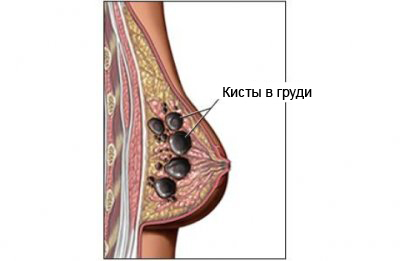Fibrotic kistoznaя boleznь – Mastopatia – Hronicheskiy kistoznыy mastitis – Dysplasia of the breast
Description of fibrocystic disease
Fibrocystic breast disease occurs, When there are filled with fluid cystic mass of adhesive fabric. These look like a mass of tissue in the breast capsules.
Although they are harmless, These masses can sometimes be the cause of pain (mastalgïya), that is repeated at the end of each menstrual cycle. The biggest problem with fibrocystic disease – the likelihood of breast cancer. Some forms of fibrocystic disease occur in women in the early stages of breast cancer.

Reasons for fibrocystic disease
Glandular breast tissue monthly, during menstruation, expanding to prepare for pregnancy, and then decreases, If it does not occur. This cycle causes cysts to grow and excess fabric. Almost all women have some form of this disease within the reproductive age, Although the majority of women do not seek medical help.
Risk factors for fibrocystic disease
All women during puberty and menopause are at risk for this disease.
Symptoms of fibrocystic disease
- Multiple cysts, usually both mammary glands, uplotnjajushhiesja during the menstrual cycle;
- Cysts may not cause any symptoms or cause pain and sensitivity;
- Fibro-kistoznuju tumor may be difficult to distinguish from cancer. Its rapid disappearance after menstruation and the emergence of the following menstrual cycle will help you distinguish this condition from breast cancer.
Diagnosis of fibrocystic disease
The doctor asks about the symptoms and medical history, and performs a physical exam. There are only two problems, that arise when you have symptoms:
- The inconvenience;
- The risk of breast cancer.
Tests may include the following:
- Mammography (chest X-ray). Mammogram alone cannot reliably differentiate benign cysts and cancer. Cysts, with whom does not originate significant monthly changes should be evaluated using other tests;
- Aspiration with a needle (If you remove the liquid, the cyst is usually);
- Эkstsizionnaya biopsy the poison plot.
Treatment of fibrocystic disease
Once it was determined, that cyst is not cancerous tumor, It can be left alone. If in doubt, the biopsy should be carried out.
Aspiration
After numbing the area local anesthesia, syringe with a fine needle is inserted into the problem area, to filter the fluid from it. If the tumor disappears, cancer is unlikely. If the tumor remains, You must study the problem area, To make sure, that cancer is present.
Biopsy
There are two types of biopsies:
- Fine needle biopsy is almost identical to the aspiration. The only difference is that, that of the total weight shown in a tiny piece of tissue;
- Excisional biopsy removes the entire cyst in a lump sum through surgical incision. This procedure can be done under local anesthesia, If the tumor is small and superficial.
Once diagnosed with cancer has been excluded, for fibrocystic disease can apply conservative measures, including:
- Intake of painkillers;
- Hormonal drugs (for severe symptoms);
- The use of hot water bottles;
- Wearing a bra that supports;
- Changing your diet (eg, exception of caffeine, intake of vitamin e).
Fibrocystic disease prevention
There is no way to prevent the Fibro-kistoznuju disease. The most important issue for the patient and doctor – to distinguish this condition from breast cancer. You need to follow the instructions of your doctor for breast cancer. Recommendations for women, without a high risk of developing breast cancer:
- Mammogram:
- Age 40-49 – It is recommended that you perform the screening every 1-2 year;
- Age 50-74 – It is recommended that you perform the screening every 1-2 year;
- Clinical breast exams:
- Age 20-39 – It is recommended that you perform the inspection of every 1-3 year;
- Age 40 and older – It is recommended that you perform the inspection every year;
- Breast self-exam:
- Age 20 and older – Optional; need to consult with your doctor about the possible risks.
